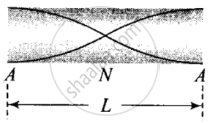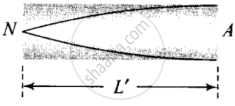Advertisements
Advertisements
प्रश्न
An organ pipe of length L open at both ends is found to vibrate in its first harmonic when sounded with a tuning fork of 480 Hz. What should be the length of a pipe closed at one end, so that it also vibrates in its first harmonic with the same tuning fork?
उत्तर

For the first harmonic of open organ pipe L = `λ/2`
⇒ λ = 2L
⇒ `v/f_0` = 2L
⇒ `(f_0)_"open" = v/(2L)`
Where v is the speed of the sound wave in air.

For the first harmonic of closed organ pipe L' = `λ/4`
⇒ λ = 4L'
⇒ `v/f_0` = 4L'
⇒ `(f_0)_"close" = v/(4L^')`
⇒ `v/(2L) = v/(4L^')` .......[∵ Speed remains constant]
⇒ `L^'/L = 2/4 = 1/4`
⇒ `L^' = L/2`
APPEARS IN
संबंधित प्रश्न
A pipe 20 cm long is closed at one end. Which harmonic mode of the pipe is resonantly excited by a 430 Hz source? Will the same source be in resonance with the pipe if both ends are open? (Speed of sound in air is 340 m s–1).
Explain why (or how) In a sound wave, a displacement node is a pressure antinode and vice versa,
Two wires are kept tight between the same pair of supports. The tensions in the wires are in the ratio 2 : 1 the radii are in the ratio 3 : 1 and the densities are in the ratio 1 : 2. Find the ratio of their fundamental frequencies.
The displacement of a string is given by y (x, t) = 0.06 sin (2πx/3) cos (120 πt) where x and y are in m and t in s. The length of the string is 1.5 m and its mass is 3.0 × 10−2 kg.
- It represents a progressive wave of frequency 60 Hz.
- It represents a stationary wave of frequency 60 Hz.
- It is the result of superposition of two waves of wavelength 3 m, frequency 60 Hz each travelling with a speed of 180 m/s in opposite direction.
- Amplitude of this wave is constant.
A pipe 20 cm long is closed at one end. Which harmonic mode of the pipe is resonantly excited by a source of 1237.5 Hz? (sound velocity in air = 330 ms–1)
The pattern of standing waves formed on a stretched string at two instants of time are shown in figure. The velocity of two waves superimposing to form stationary waves is 360 ms–1 and their frequencies are 256 Hz.

- Calculate the time at which the second curve is plotted.
- Mark nodes and antinodes on the curve.
- Calculate the distance between A′ and C′.
Two travelling waves produce a standing wave represented by the equation. y = 1.0 mm cos (1.57 cm-1) x sin (78.5 s-1)t. The node closest to the origin in the region x > 0 will be at x = ______ cm.
Two closed end pipes when sounded together produce 5 beat per second. If their length are in the ratio 100 : 101, then fundamental notes produced by them are ______.
A tuning fork of frequency 480 Hz is used in an experiment for measuring the speed of sound (ν) in the air by resonance tube method. Resonance is observed to occur at two successive lengths of the air column, l1 = 30 cm and l2 = 70 cm. Then, ν is equal to ______.
A string 2.0 m long and fixed at its ends is driven by a 240 Hz vibrator. The string vibrates in its third harmonic mode. The speed of the wave and its fundamental frequency is ______.
